Hidden Gems of the Provence Coastline Unearthed
Jennifer Ladonne breaks away from the tourist trail and finds some unspoilt beauties along the French Riviera
Provence is a many splendoured thing, and one of its many great splendours is its coastline. Stretching from the Rhône estuary in the wild and desolate Camargue some 200 miles east to the Italian border, coastal Provence lays claim to everything from shimmering beaches and yacht-clogged harbours to azure, sheltered coves and charming fishing villages.
Happily, France’s most storied – and overrun – coastal stretch still conceals a few hidden gems not listed in the guidebooks and undiscovered by the hordes. While the Côte d’Azur needs no introduction, and Provence aficionados have long enjoyed the picturesque shores between Marseille and Sanary-sur-Mer, tucked between the two, near Toulon at the French mainland’s southernmost tip, lies a stretch of coastline that falls into a blind spot on the tourist radar.
- Fishing boats in Le Gaou. Photo credit © Robert Palomba
- The area offers a more relaxed version of the Riviera. Photo credit © Ville-de-Sanary-sur-Mer
Holidaymakers tend to give Toulon and its immediate surroundings a wide berth, mostly due to the city’s unfortunate – and, more recently, undeserved – reputation as a bleak industrial centre lacking in charm.
Just west of Toulon, jutting out into the Mediterranean, Six-Fours-les-Plages, La Seyne-sur-Mer, Île des Embiez and Saint-Mandrier-sur-Mer have languished in Toulon’s shadow. As a result, these seaside destinations, despite possessing much of the same Riviera allure as their more famous neighbours – sans the snob appeal – do not attract the same crowds.
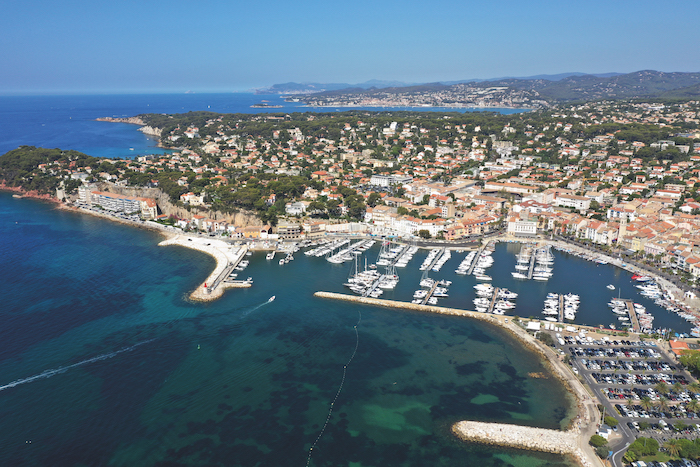
Boats bob in the harbour at pastel-hued Sanary-sur-Mer. Photo credit © Ville-de-Sanary-sur-Mer
Sunlit Heavens
For all its sunlit charm, even tiny Sanary-sur-Mer, a pastel-hued port 36 miles from Marseille which in the Second World War was a haven for Germany’s great authors and artists in exile – Lion Feuchtwanger, Thomas Mann, Bertolt Brecht, among others – is still little known outside France. Take an abrupt turn south along the Six-Fours-les-Plages coastline and you’ll step right off the tourist circuit.
The coastline from Sanary, past the town of Les Lones and south to the Îles du Grand et Petit Gaou, attracts surfers (at Brutal Beach) and walkers for its long, scenic coastal path. From Sanary, it’s about a four-mile walk past Cap Nègre and a handful of picturesque inlets and bustling beaches all the way to the Le Brusc, a tiny fishing port where you can hop aboard a ferry to the shimmering Île des Embiez.
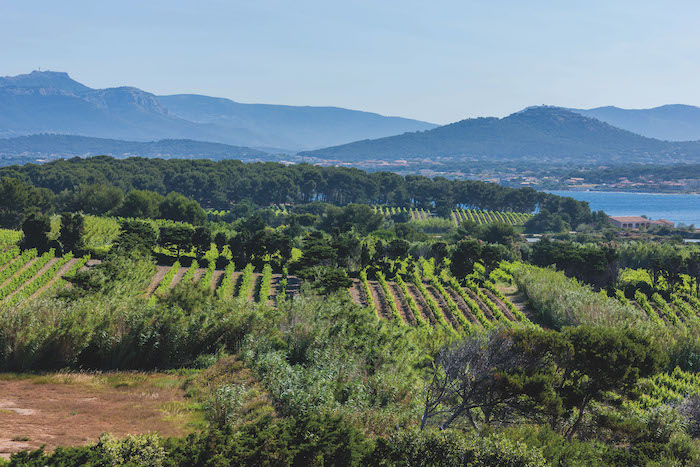
Les Embiez vineyards, Côtes de Provence. Photo credit © Roberto Palomba
In the 1950s, the self-made pastis baron Paul Ricard, whose secret recipe for Pernod Ricard made him a millionaire by the age of 30, bought several uninhabited islands. Embiez, the largest, harbours 90 per cent of the Mediterranean’s plant species and is home to a bird sanctuary and nature reserve as well as the Institut Océanographique Paul Ricard, dedicated to ocean research and conservation. Craggy Embiez’s striking landscapes and rolling vineyards are easily explored on foot; all the better to stop along its rocky beaches and crystal-clear turquoise waters for a swim (beach shoes recommended) or climb its gentle slopes for limitless views of azure sea and sky. Ricard’s modest, windswept grave, facing his beloved Mediterranean, commands one of the island’s loveliest views.
The ferry ride from Port Brusc to the 250-acre island takes 12 minutes, and overnight visitors have the choice of two hotels, 150 guest apartments or a private villa. There are several restaurants on the island, a wine Clockwise from main: The view of Les Embiez from Le Gaou across crystal waters; Edith Wharton’s beloved Castel Sainte-Claire; Les Embiez vineyards; the area offers a more relaxed version of the Riviera; boats bob in the harbour at pastel-hued Sanary-sur-Mer bar and a grocery store for picnic provisions. If you don’t fancy walking, you can circumnavigate the island on a small tourist train. Two much smaller, very pretty islands, Grand and Petit Gaou, are easily reached on foot or via a short drive from Port du Brusc.

Edith Wharton’s beloved Castel Sainte-Claire. Photo credit © Pierre Lisse, Hyères Tourisme
At the tip of the La Seyne peninsula, and covering nearly a third of its landmass, a lush, protected forest of oak, olive, cork and pine trees covers the Massif du Cap-Sicié, which rises 1,200 feet straight up from the sea. Criss-crossed by miles of walking, horseback riding and mountain biking trails, it’s an ideal landscape for enjoying the outdoors. Some trails take you down steep paths to the almost-inaccessible seaside, others up to the 17th-century Notre-Dame du Mai chapel, known for its December pilgrimage and its commanding 360-degree views. It’s also a breathtaking drive, but trails are closed to cars between June and September.
Of Cap-Sicié’s 20 or so hiking trails, half begin in Ollioules, a quaint medieval village set just above the peninsula. It’s well worth a morning visit for the village’s many artists and artisans, its typically Provençal market on Thursday and Saturday mornings, and Nougat Jonquier, a small factory and boutique where visitors are initiated into the secrets of the traditional Provençal sweet. Jonquier, where everything is still handmade, is among the few remaining nougat makers to use real honey, a delicious pairing with roasted nuts, lightly perfumed with orange blossom, caramel, violet and a number of other fruits and flowers.
- check out the bustling markets in La Seyne-sur-Mer and Ollioules. Photo credit © Robert Palomba
- La Seyne-sur-Mer fish market. Photo credit © Robert Palomba
Beachcombers will find plenty to do on the eastern side of the peninsula at La Seyne-sur-Mer, a seaside resort that still bears the traces of its heyday as one of France’s great shipbuilding towns. Half a dozen secluded beaches cluster along its eastern edge, including Plage Naturiste du Saint-Selon, one of the area’s few nudist beaches. But the biggest draw is Les Sablettes, a sprawling white-sand beach on the narrow strip of land that connects Saint-Mandrier-sur-Mer, a hilly, wooded peninsula, to the mainland.
Lined with hotels, brasseries and cafés, Les Sablettes has the Riviera allure without the glitz or expense. For a feel of the area’s Belle-Époque grandeur, the Grand Hôtel des Sablettes, reopened in 2018 after an elegant top-to-toe renovation, is an excellent base and puts you right on the beach. Besides excellent views of Saint-Mandrier, the Toulon coastline and ships heading to Sardinia and Corsica, the ferry ride from Tamaris Bay to Toulon takes you past some of the south’s most prized oyster and mussel beds, bounty you’ll find in top restaurants throughout Provence.
Though facing Toulon on its northern side, Saint-Mandrier-sur-Mer feels like a world apart. Its postcard-worthy port and rocky coastline harbouring small inlet beaches, and relative lack of crowds, have made the tiny peninsula – which feels more like an island – a favourite among boaters, scuba divers and swimmers. Its many walking trails zigzag up three hills to lovely vistas and down to secluded inlets, though some are best reached by boat. Toulon is an easy ferry ride from Les Sablettes or La Seyne-sur-Mer, a Belle-Époque town that still bears the vestiges of its maritime prosperity.
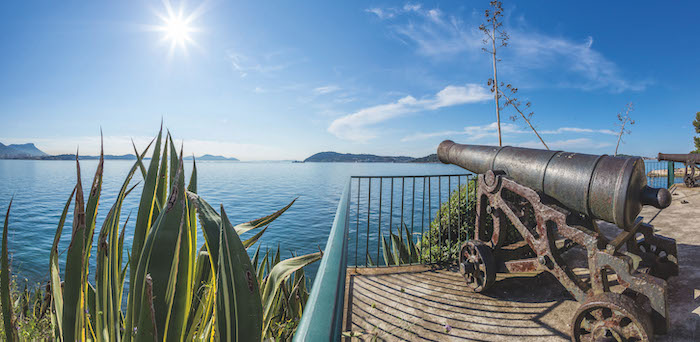
The fascinating Musée Balaguier is set in a 17th-century fort. Photo credit © Robert Palomba
Hidden Culture
Much smaller and less cosmopolitan than Provence’s other big coastal cities, Marseille and Nice, Toulon has little of their cultural – or multicultural – appeal. This maritime city is best known as France’s largest naval base and a shipbuilding centre, a status that has defined Toulon since at least the second century and still defines it today. As a crucial port during the Second World War, Toulon’s seafront suffered near total destruction by the Allied forces and was rebuilt in a lacklustre style devoid of the charm of its Mediterranean counterparts.
At the beautifully refurbished Mémorial du Débarquement de Provence, visitors get an in-depth account of the pivotal, intricately planned Allied attack on Provence’s coastline which was crucial in retaking the south’s two vital ports, Toulon and Marseille, from the Nazis. Reached via a thrilling six-minute cable car ride 2,000 feet above Toulon to the summit of Mont Faron, the museum also affords spectacular views of the entire Toulon bay and Riviera coastline and is alone worth a side trip to the city.
But if you’re inclined to explore Toulon, you won’t be disappointed. Its picturesque Vieille Ville (Old Town), largely spared during the war, is on the upswing. Along pretty cobbled streets you’ll find the superb 1880s opera house, the second largest in France after Paris’s Opéra Garnier, and a warren of restored medieval and Renaissance buildings teeming with art galleries, artisan boutiques, coffee shops and wine bars. Go on Saturday for the charming morning market winding down shady medieval streets. Then spend the afternoon lounging on one of the city’s long sandy beaches, across from the upmarket 19th-century villas and palm-shaded gardens lining Le Mourillon.

The Opéra house at Toulon. Photo credit © Toulon Tourisme
Island Life
If it’s beaches you’re after, get thee to the Îles d’Hyères. A cluster of three jewel-like islands, of which the largest, Porquerolles, France’s southernmost point, possesses the “best beaches in Europe”, according to European Best Destinations. But first, make a quick stop in Hyères, where you’ll catch the Porquerolles ferry.
Hyères has two claims to fame: first, as the long-time host of the International Festival of Fashion, which bestows the country’s most prestigious awards to young French fashion designers; second, as the historic gateway to the Côte d’Azur.

Hyères is brimming with medieval charm. Photo credit © Pierre Paret, Hyères Tourisme
This quintessentially Belle-Époque town, the Riviera’s oldest resort, was discovered by the British in the mid-1700s, and became a favourite haunt of Queen Victoria, along with a steady stream of authors, such as Rudyard Kipling, Leo Tolstoy, Robert Louis Stevenson and Edith Wharton.
Perched high above the city, Hyères’s medieval old town’s three concentric walls contain enough to keep you busy for at least a day: check out the Knights Templar Tower and Wharton’s beloved Castel Sainte-Claire gardens, where the author lived, wrote and delighted in getting her hands dirty between 1927 and 1937. Above the gardens, the whitewashed Villa Noailles is a pinnacle of early modernist architecture, built by Robert Mallet-Stevens for the socialite art patrons Charles and Marie-Laure de Noailles between 1923 and 1927. Both the gardens and villa afford spectacular views of Hyères and the sea. Wine lovers can also visit Hyères’ 20 or so wineries to sample the region’s famously pale and flowery rosés.

The Knights Templar Tower is among Hyè res’s many attractions that make it worth a visit. Photo credit © Pierre Lisse, Hyères Tourisme
At the tip of Hyères’s unique double-sided landmass, La Tour Fondue (a haven for pink flamingos), a 10-minute ferry ride takes you to the Île de Porquerolles, the largest and most visited of the three Îles d’Hyères. All three are national nature preserves, while the other two islands, Port-Cros and Le Levant, contain, respectively, a former military base and a France’s longest-established nudist colony.
Wooded Porquerolles does not allow cars, so most tourists get around by bike, which can be rented for about €30 a day. Trails criss-cross the island, the prettiest taking you past the Plage de Notre-Dame, a long stretch of white sand fronted by limpid turquoise waters, and up a rocky path to an old Napoleon-era fort with eye-popping views. Between September and early November, when it’s still warm enough to swim, you may well have the beach to yourself.
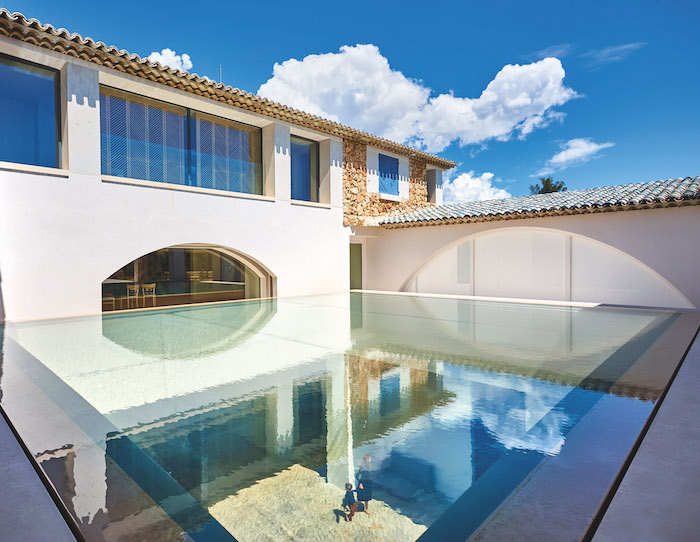
Get your art fix at Fondation Carmignac. Photo credit © Laurent Lecat
Another draw to Porquerolles is the newly opened Fondation Carmignac, an offshoot of the Paris contemporary arts foundation, whose extensive grounds contain one of the island’s two notable vineyards (the other was recently bought by Chanel) and an A-list of contemporary land art and outdoor sculptures. The spacious, day-lit indoor galleries are lodged in a lavishly restored stone farmhouse, home to a smashing collection that includes the likes of Gerhard Richter and Jean-Michel Basquiat and rotating exhibitions by top-tier contemporary artists.
In Porquerolles and the rest of this unselfconscious region, there’s a blessed lack of bling. Sea breezes, relaxation, beach lounging, wine tasting, boating, fun in the sun and scenic walks are the activities you’ll enjoy in this lovely, unspoilt gateway to the Riviera.
Riviera Essentials
Hotels
- La Seyne-sur-Mer
Grand Hôtel des Sablettes - Hyères
Castel Pierre Lisse - Porquerolles
Hôtel Villa Sainte-Anne
Resources
Download free hiking maps of Cap-Sicié or Ouest Var Tourisme
From France Today magazine

Photo credit © Pierre Paret, Hyères Tourisme
Share to: Facebook Twitter LinkedIn Email
Leave a reply
Your email address will not be published. Required fields are marked *

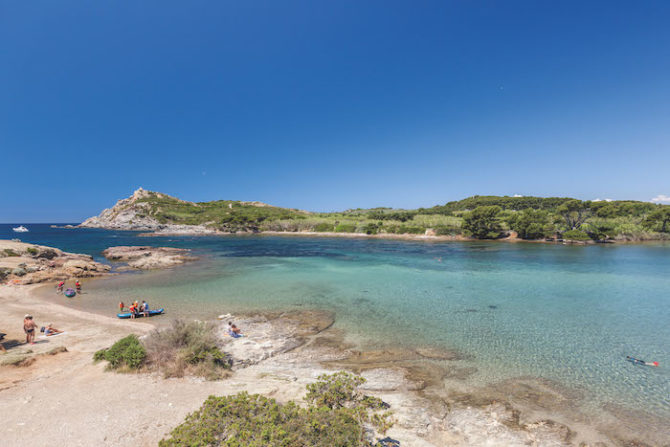

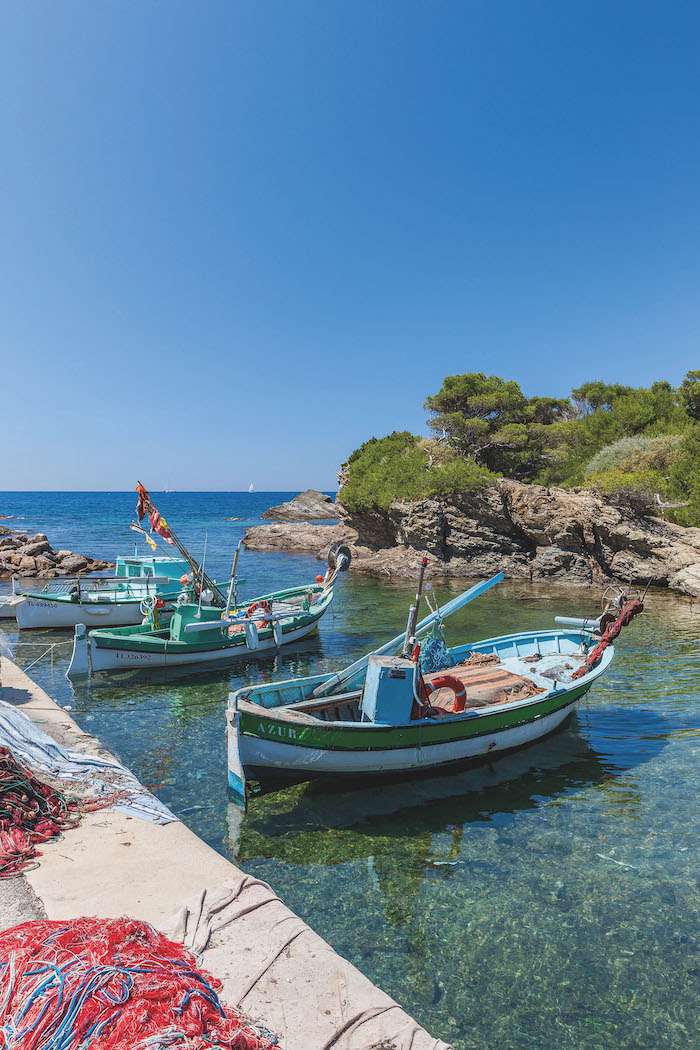
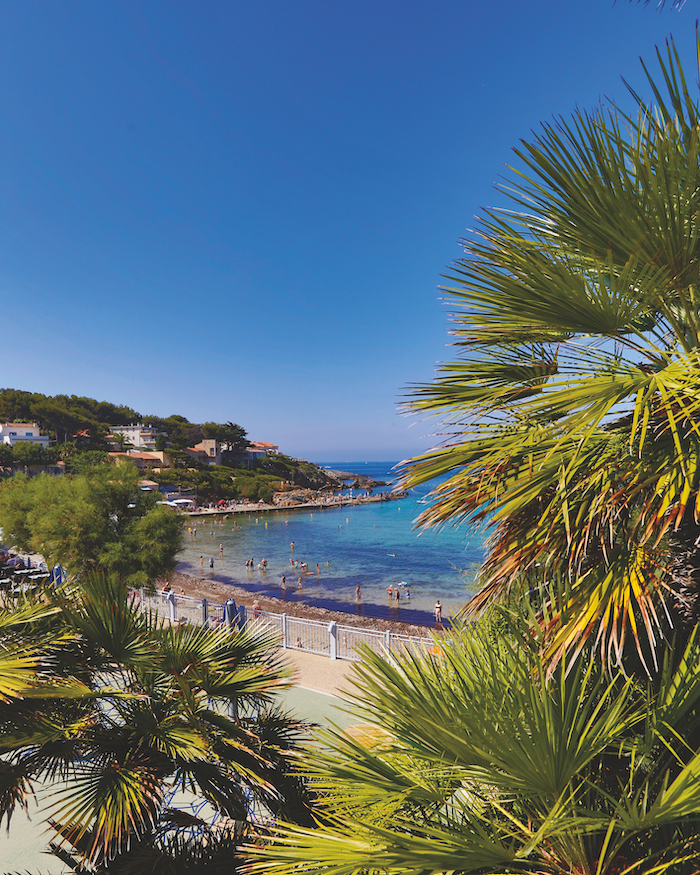
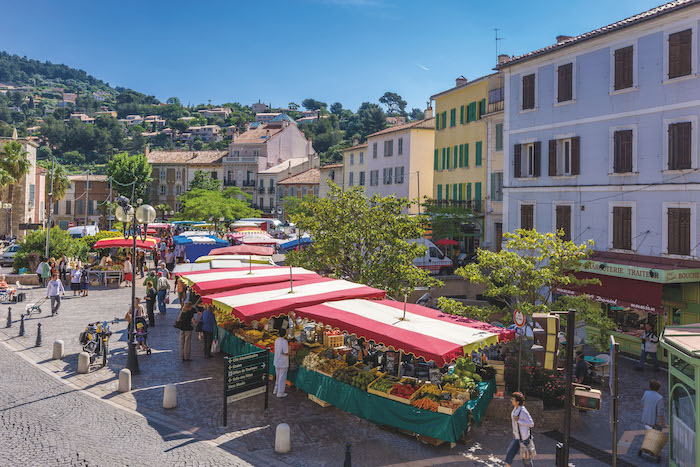
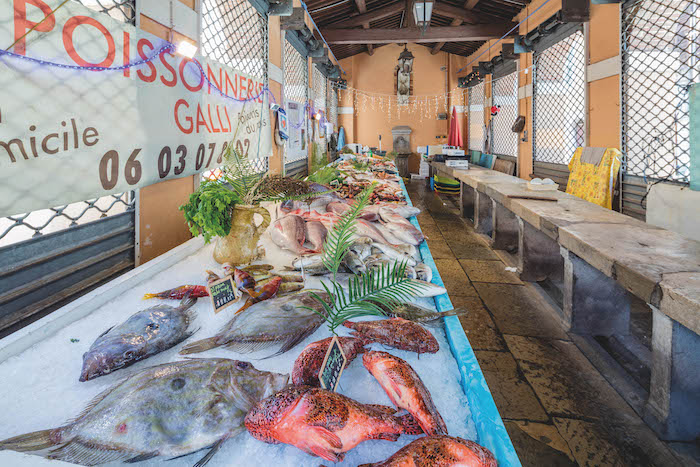



REPLY